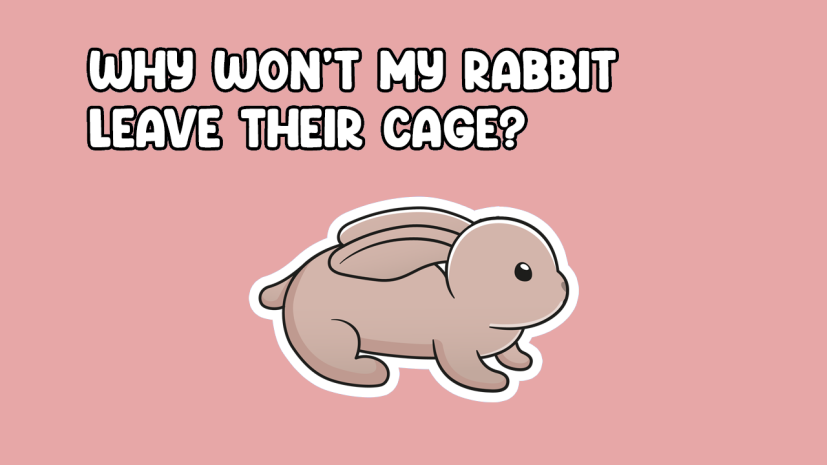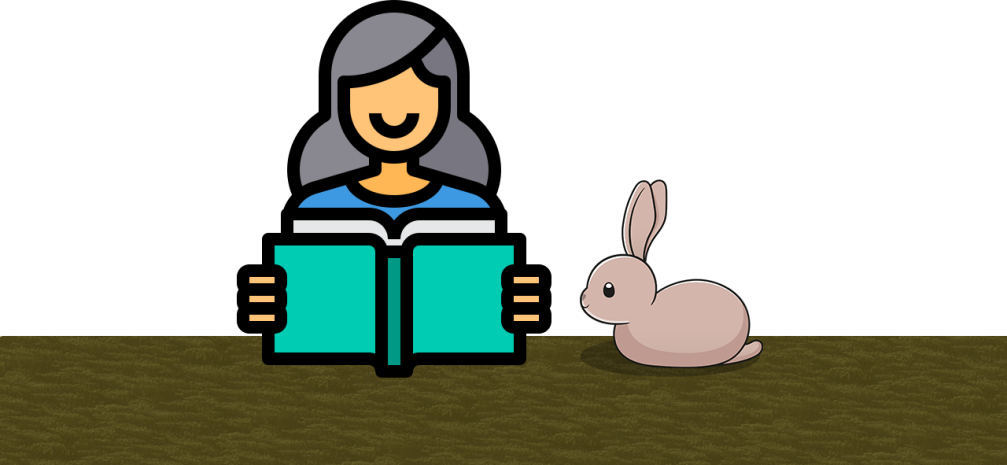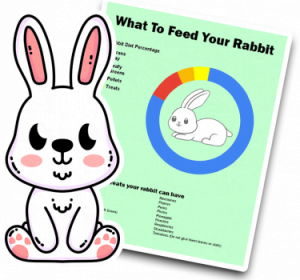
Rabbits are extremely fun and energetic companions, but they are still prey animals, and this can lead to some hesitant and anxious-driven behavior. Like any animal, rabbits have their own behaviors that can confuse their human caretakers.
One of the most common and puzzling behaviors of rabbits is hiding. This article will dive deep into rabbit hiding and provide a comprehensive guide to understanding why rabbits hide, how to identify hiding behavior, and what it means.
So, why won’t your rabbit come out and play? – Getting your Rabbit to leave their cage for the first time or in a new environment can be difficult. Newer rabbits are usually shy and will be hesitant around people they’re not familiar with. Additionally, your rabbit may suffer from boredom, illness, or even something more common, like sleepiness and old age.
Learning to understand your rabbit’s behavior is a key component to knowing what you need to do to get your rabbit to come out of its cage and crucial to know what its current ailments are.
Identifying rabbit hiding behavior can be challenging, as rabbits are experts at hiding. However, there are some signs to look out for, including:
If you notice any of these signs, observing your rabbit’s behavior closely and identifying the underlying cause is essential. A lack of eating, drinking or using the litter box can be a clear sign of GI Stasis or problems like dental pain and require a veterinarian urgently.

As prey animals, rabbits are naturally timid and may hide if they feel threatened or scared. Loud noises, unfamiliar people, and other animals in the home can all cause a rabbit to feel afraid and retreat to a hiding spot. Signs that your rabbit is hiding out of fear include flattened ears, hunched posture, and avoidance behavior.
To help your rabbit feel safe and secure, provide a designated hiding spot in their living area, such as a box or tunnel. Additionally, create a quiet and peaceful environment for your rabbit and avoid sudden loud noises or movements. Your rabbit may become more comfortable and confident in their surroundings with time and patience.
Everyday things that rabbits can be scared of inside your home are ceiling fans, loud noises, changes in smell (Like cooking meat or garlic) & other pets.

If a rabbit is not feeling well or is injured, it may retreat to a hiding spot to rest and recover. Some common signs of illness or injury in rabbits include lethargy, lack of appetite, and changes in bowel movements.
If you suspect that your rabbit is hiding due to illness or injury, it’s essential to seek veterinary care as soon as possible. Delaying treatment can lead to further health complications and even death. Your veterinarian can diagnose and treat your rabbit’s underlying condition, as well as provide supportive care to help them feel comfortable and secure.

Rabbits are sensitive animals and can become stressed in unfamiliar or loud environments. Changes in routine, introducing new pets like cats or dogs, and other disruptions can all cause a rabbit to feel stressed and retreat to a hiding spot. Signs that your rabbit is hiding due to stress include lack of appetite, lethargy, and changes in behavior.
To help your rabbit feel less stressed, create a predictable and stable routine and avoid sudden environmental changes. Provide your rabbit with a safe and comfortable hiding spot and spend time with them to help them feel secure. Additionally, consider using calming supplements or pheromone sprays to help your rabbit feel more relaxed.
If rabbits feel threatened or uncomfortable in their environment, they may hide to feel safe. This could be due to a change in living arrangements, such as moving to a new home or rearranging furniture. Signs that your rabbit is hiding due to feeling threatened include avoiding eye contact, hunching their body, and tucking their tail.
To help your rabbit feel more comfortable in their environment, provide them with a designated hiding spot and allow them to explore their surroundings at their own pace. Additionally, avoid sudden changes in their living area and provide plenty of toys and treats to keep them stimulated.

As rabbits age, they may become less active and more prone to hiding. This is a natural part of the aging process, and providing a safe and comfortable environment can help your rabbit feel secure. Signs that your rabbit is hiding due to age-related changes include decreased activity levels, changes in appetite, and increased sleep.
To help your senior rabbit feel more comfortable and secure, provide them with a warm, cozy environment and plenty of soft bedding. Additionally, consider modifying their living area to make it easier for them to access food, water, and litter boxes.

Rabbits, like all animals, can experience depression. Signs of depression in rabbits include a lack of appetite, lethargy, and changes in behavior. If you suspect your rabbit is depressed, it’s essential to consult with a veterinarian to identify the underlying cause and provide appropriate treatment.
To help your rabbit overcome depression, spend more time with them, provide them with toys and treats, and engage them in playtime. Additionally, ensure their living environment is clean, comfortable, and stimulating. Your veterinarian may also recommend medication or other treatments to help your rabbit feel better.

Ensure your rabbit has a designated hiding spot to which they can retreat if they feel threatened or anxious. This could be a box, a tunnel, or a designated area under furniture.
Ensure that the hiding spot is clean, quiet, and well-ventilated. You may also want to cover the hiding spot with a towel or blanket to make it feel more secure.
It’s important to note that you should not force your rabbit out of its hiding spot. Allow them to come out on their own terms and provide a safe and comfortable environment where they can feel secure.
Rabbits are sensitive animals and can become stressed in loud or chaotic environments. Create a peaceful and quiet environment for your rabbit to feel safe and secure. Avoid sudden loud noises, bright lights, and stressful situations. Consider playing soothing music or white noise to help your rabbit feel more relaxed.
Additionally, make sure your rabbit’s living area is clean and comfortable. Provide fresh water and food daily, and keep the litter box clean and well-maintained. A clean and comfortable environment can help your rabbit feel more secure and relaxed.

Spend time with your rabbit to help them feel comfortable and secure in their environment. This can include petting, playing with, or sitting quietly beside them. Talk to your rabbit softly and soothingly, and avoid sudden movements that could startle them.
Many owners will read to their rabbits in a gentle tone to help them get familiar with your voice and show that you mean no harm.
Additionally, ensure your rabbit has plenty of opportunities for exercise and playtime. This can include setting up obstacle courses or providing toys and chewable to keep them entertained and stimulated.
Avoid holding your rabbit if they hide or display signs of fear or anxiety. Rabbits are prey animals and can become frightened or stressed when picked up or restrained.
Unless your rabbit was handled a lot as a kit (baby rabbit), they might find being picked up extremely scary, making them even more restless.
When rabbits feel threatened or unsafe, they may try to escape or struggle, which can lead to injury. Additionally, holding your rabbit can increase their stress levels and make it more difficult for them to feel safe and secure in their environment.
If you need to move your rabbit, it’s best to lure them out of its hiding spot with treats or a favorite toy. You can also use a box or carrier to transport them if necessary. Always handle your rabbit gently and avoid restraining them if possible.
Remember that every rabbit is unique and may have different preferences and levels of comfort in handling. Some rabbits may enjoy being picked up and held, while others prefer being left alone. It’s essential to respect your rabbit’s boundaries and comfort levels and provide them with a safe and secure environment where they can feel happy and relaxed.

Treats and toys can help your rabbit feel happy and secure in their environment. Provide your rabbit with chew, puzzles, and other stimulating toys to keep them entertained and engaged. Additionally, provide your rabbit with healthy treats, such as fresh vegetables and fruits, as a reward for good behavior.
Here are some tips for giving your rabbit treats:
It may take time for your rabbit to feel comfortable leaving hiding. Be patient and allow your rabbit to come out on their own terms. Avoid forcing them out of their hiding spot or making sudden movements that could startle them.
Remember that every rabbit is unique and may take different amounts of time to feel comfortable and secure. With patience and time, your rabbit will begin to feel more comfortable and may start to come out of hiding more frequently.
If your rabbit’s hiding behavior is out of character or you notice other concerning symptoms, seek veterinary care to identify any underlying medical issues. Your veterinarian can also guide how to help your rabbit feel safe and secure.
Common signs of illness in rabbits include lethargy, lack of appetite, and changes in bowel movements. If you notice these symptoms, you must seek veterinary care immediately to ensure your rabbit’s health and well-being.
Gi Stasis is a very critical illness for a rabbit, so the sooner he gets treatment the better.

By entering your email address you agree to receive emails from Cottontailclub. We'll respect your privacy and you can unsubscribe at any time.